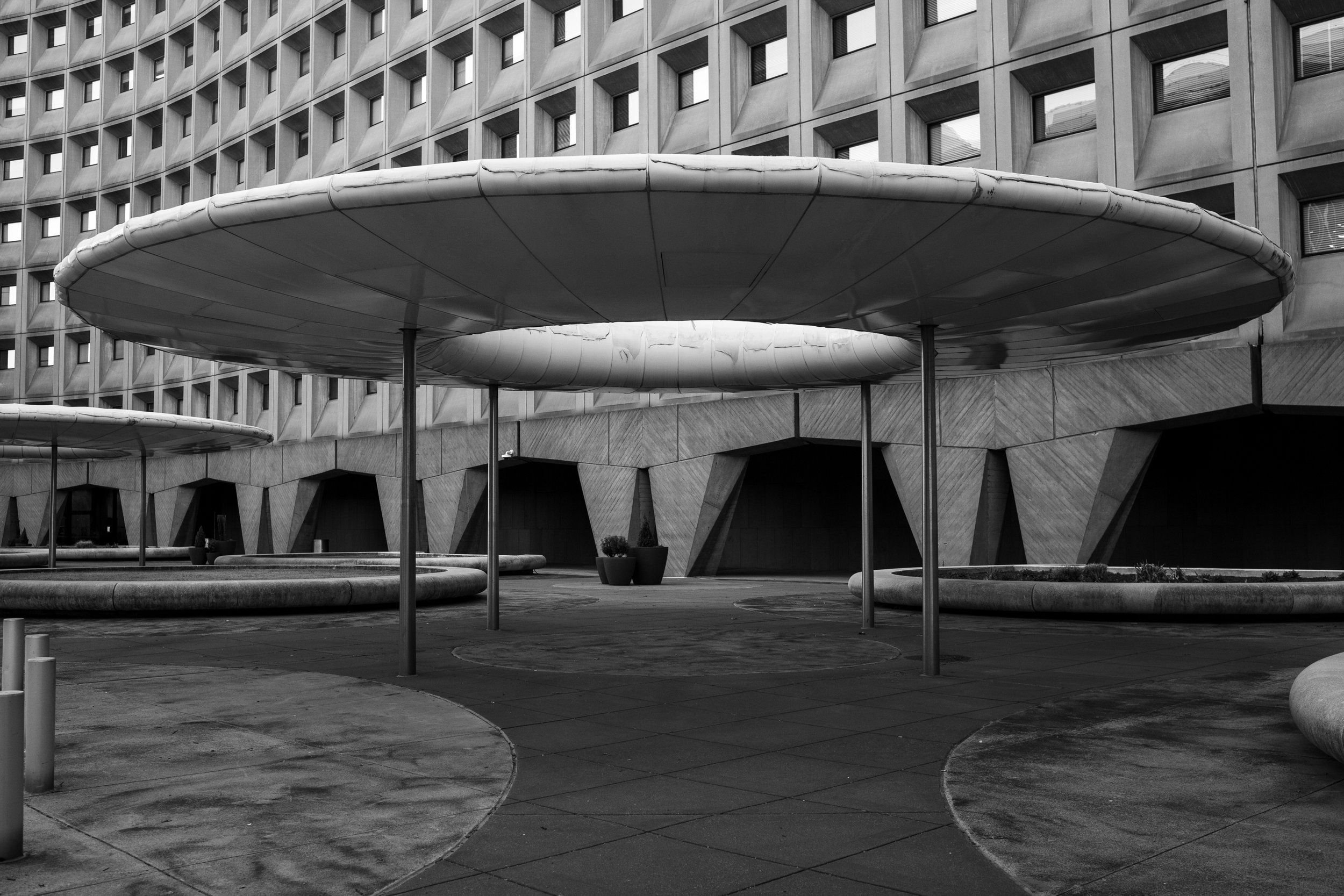4.1.25: L'Enfant Plaza + HUD
Starting at the end of last year, my friend Sandy (a very talented photographer and native Washingtonian) and I have taken semi-regular walks around the city. We first met outside of the Supreme Court while we were both taking photos independently of Ruth Bader Ginsburg’s coffin on the court steps in September 2020.
It’s easy to meet fellow photographers at historic events (or any number of protests, direct actions, and rallies around the city), but becoming actual friends with anyone (especially introverted photographers—like myself—who prefer being behind the lens for a reason) requires a bit of work from both parties involved.
When Sandy suggested we begin to take dedicated photo walks—with no set agenda other than the expectation that we would see some cool stuff and each document it in our own ways—I was thrilled. We squeezed in one last walk before my recent hip surgery, this one dedicated to the often-maligned architecture so prominent in the District: Brutalism.
We started our walk in L'Enfant Plaza, a late-1960s urban renewal project that came at the expense of a majority-Black neighborhood, whose residents were forced out by eminent domain. The project was almost immediately plagued by delays, funding deficits, and other bureaucratic problems, but the original design was provided by I. M. Pei.
Most of the buildings razed were Victorian row houses; they were replaced with four large office buildings (North, South, East, and West)—which at various times in history have housed a hotel, movie theater, and the U.S. Postal Service’s headquarters—in addition to a sweeping promenade and an underground mall. In 2019, the International Spy Museum relocated to a new building located across the plaza from the USPS.
Only a few years after its dedication, the hulking James V. Forrestal Building cut off the plaza’s view of the National Mall, but it was a net-positive for fans of Brutalism (which does not include famous paragon of good taste, Donald Trump). I’ll leave the architectural criticism to real architects, but to me (and luckily Sandy as well), Brutalist buildings are a dream to photograph.
It wasn’t long into our walk before Sandy pointed out that I could switch my camera settings to capture in black and white; it technically captures in color as well, but displays in black and white—which might not seem like that big of a deal in the digital age, but it really changed how I composed and shot photos for the rest of the day.
Aside from a few high school and college classes, I’m not a well-trained or professional photographer, but I’ve mostly gotten over any insecurities I have when it comes to making or sharing photos. Yes, almost everyone is a photographer now that we all have phones with remarkable cameras in our pockets at all times, but for me, using my “big camera” is the perfect way to combine my love of visual storytelling and the exploration of interesting places.
I detest gatekeeping and arrogance in any arena, but it can be especially palpable in the photography world. Even if I agree with Dina Litovsky that shooting in (or editing to) black and white can be a crutch used to artificially elevate a mediocre photograph (she calls it “art sauce”), in this case the switch reinvigorated the way I saw the plaza and street photography in general. (I joked that I suddenly felt like Berenice Abbott).
The geometric beauty of Brutalism—with its repetitive shapes, sharp angles, and dramatic shadows—can really be appreciated without the added distraction of color. Forcing myself to focus on light and dark, lines and shapes, and the stoic interplay between all of it, was a fun departure from the colorful chaos of a protest or other people-centric event.
Right next to L’Enfant Plaza is the Robert C. Weaver Federal Building, built by the GSA in 1968, and home to the U.S. Department of Housing and Urban Development (HUD). Designed by architect Marcel Breuer, and added to the National Register of Historic Places in 2008, the HUD building has always stopped me in my tracks with it’s sweeping, curved facade that looks like a capital I (with bent serifs) from above.
In the early 1990s, landscape architect Martha Schwartz was commissioned to redesign the plaza. The finished product is the result of compromises requested by then-Secretary Andrew Cuomo (this fucking guy!), who nixed Schwartz’s brightly-colored canopies in favor of neutral white. The circular structures have been compared to UFOs (both negatively, and positively), and in 2004 The Project for Public Spaces rated the plaza the eighth-worst public plaza in the world (agree to disagree!).
































